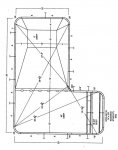Matt...thanks for all of the helpful information, this is what I need. We have had our well water tested and no lead, there is some sulfate that you can smell sometimes (we have a purifier for our house but not the outdoor water). Can the cartridge cleaning be something that the company that closes the pool does or is that just too lazy? Will it have to be done more frequently then that, I know that depends on filter size and how much debris we have but are there some general recommendations, I don't know how accurate they are or how much wiggle room there is. I'm guessing that we will have the pool open for about 4 months per year. I'd also like your opinion on the intellichlor60 with a variable pump.
Hi Karen,
Love the backyard, I miss the big tree back East (I grew up on Long Island). Your pool is going to look awesome back there.
As for chemicals, it's not a matter of evaporation that controls FC level but exposure to UV and water temperature. Being in the desert southwest, I am several degrees latitude lower than you. Therefore my UV exposure is higher. Chlorine is used up by three things in water - biological critters (algae, bacteria & viruses), organic contamination (sweat, urea, etc, otherwise known as bather waste) and ultra-violet light. The more UV exposure you have, the greater the loss rate of FC. As for temperature, we start hitting the 90's here in Tucson in May and, by the height of the summer swim season outdoor temps peak to 110F. My water will be 90F just from absorbing heat alone (no need to run a pool heater). Higher temperatures means faster chemical reactions which equal more chlorine loss. So, yes, you folks up north benefit from the cooler climate (but you pay for it with pool heaters

).
A cartridge filter, if it lasted all season, could be an item on a pool closing companies check list. I think up north the pool companies like to clean the equipment and remove it for storage at their facilities. If you don't pay for that as part of the closing process, then it is often recommended you clean and store your pool equipment yourself. TFP has some very good write ups on how to properly close your pool each year but, I have to say, I'm glad I live in a part of the country where my pool never has to be closed (though no one swims when the water temps are below 78F).
I love my Pentair equipment but I will say this, if you are planning to go with a full automation system, then you should stick with one brand, i.e., all Pentair or all Hayward or all Jandy. Check with your pool builders on what equipment they use because, very often, they typically build with only one brand. Specifically speaking about Pentair, an IC60 produces 2-lbs of chlorine per day. In your 35,000 gallon pool, that's about 7ppm FC per day. That should be more than enough to keep your pool going. It seems others who live in your part of the country have good luck with their Hayward T-15's in terms of adequate chlorine output so I am now less concerned about it. Even with a salt water pool, you can always supplement with a little liquid chlorine now & then to help out with the occasional pool party (I do that all the time). The most important thing to understand about an SWG is this - it requires water flow to make it work. So, in order to generate chlorine you have to run the pump AND you have to run the pump with sufficient speed to get the correct water flow through it. If the flow is too low, it will not generate chlorine. High flow is usually not a problem as few pumps can push water fast enough to really affect the SWG output (and there are ways to deal with high flow in the plumbing design anyway). So a variable speed pump is really a nice feature to have because it allows you to have different pump speeds. You can run it really low to just skim and filter water with no chlorine production or you run it a little faster to produce chlorine or you run it REALLY FAST so you can hook up a vacuum and get good suction. That's not something that is possible with a single speed or 2-speed pump.
Keep posting your questions and design plans as we all love to play virtual PB ....
Matt




 Post a full list of equipment components and the gang here will help keep you straight. Have a great weekend.
Post a full list of equipment components and the gang here will help keep you straight. Have a great weekend.